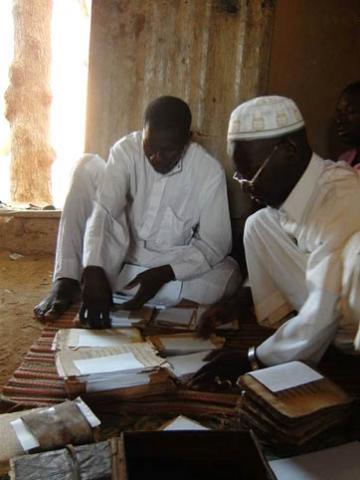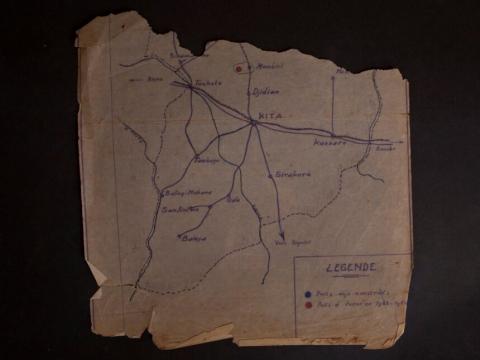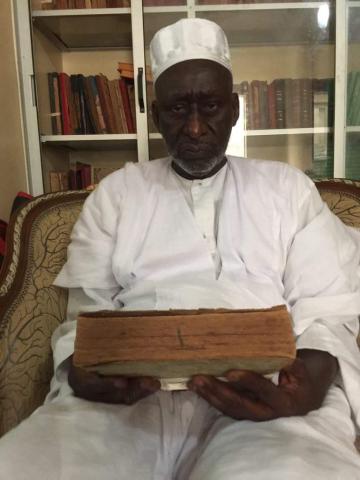Aims and objectives
The previous two major EAP projects in Djenné (EAP488 and EAP690) unearthed a vast and hitherto unexplored wealth of Arabic manuscripts in this ancient city of Djenné which shares a glorious past as a centre of learning and commerce with its more famous ‘twin sister’ Timbuktu.
This third major project will continue in the same footsteps as its preceding projects, a model which has proved to work well. However the new project will provide a higher level of professionalism through the additional staff member Saad Traoré, with his relevant expertise in the academic field of Arabic manuscripts. The other staff members will all receive a thorough fine-tuning of their skills to ensure that the standard of work remains high. The visits to the outlying villages will be continued, since it has proved a fruitful venture and many manuscript owners have been persuaded to relocate their manuscripts to the Library.
The work carried out by these EAP projects is the first and only work that has been undertaken on the manuscripts of Djenné, except for two small family libraries set up by the Malian manuscript association SAVAMA. Although Djenné can perhaps not equal Timbuktu in the sheer quantity of its manuscripts, there is no doubt that there still remains an enormous amount of manuscripts in an endangered situation both here in Djenné and in the surrounding villages, and these documents are now being brought into the library in increasing numbers. Djenné’s wealth of manuscripts, many still housed in precarious circumstances in family homes, presents in a very real sense a new challenge and a vast new and unexplored research field.
Since the pilot project EAP269 in 2009, the Djenné Manuscript Library has gradually become the custodian of over 100 families’ collections and the library has truly become a cultural centre of the town. Some families who have already given some manuscripts from their collections are now bringing their more precious manuscripts for digitisation and safe keeping, mirroring the growing confidence the library now inspires in the population. The work undertaken here by EAP during the last six years has gathered momentum and, after initial difficulties, the benefit of several years of painstaking work of confidence building in the Djenné population is now being reaped.
The oldest dated manuscript currently in the Djenne Manuscript Library is from 1394, although there are supposedly older manuscripts in the town. The majority of the manuscripts date from between 1700 to 1900. The project will digitise approximately 200,000 pages and at the end of the project, digital copies will be deposited with the Archives Nationale in Bamako, Djenné Manuscript Library and the British Library.
This latest project now provides a unique opportunity to safeguard a very important part of West African history enshrined in these manuscripts.
Outcomes
The present project has digitised just under 140 000 images from 2616 manuscripts belonging to 61 Djenné families. That is a lower figure than anticipated, but the reason for this is that we have now been able to cover almost all the manuscripts available in Djenné: there are others, but those collections belong to certain families who did not wish to take part in the project.
The records copied by this project have been catalogued as:
- EAP879/1 Collection of Arabic manuscripts from the family Alphady TRAORE 3 (17th century-20th century)
- EAP879/2 Collection of Arabic manuscripts of the family Alpha Ibrahim Sory KOUMARE 1 (20th century)
- EAP879/3 Collection of Arabic manuscripts of the family of Alphamoye Baber DJENEPO 1 (19th century-20th century)
- EAP879/4 Collection of Arabic manuscripts from the family of Ahmed Bacaïna TRAORE 10 (19th century-20th century)
- EAP879/5 Collection of Arabic manuscripts of the family Soumana BOUARE 2 (Late 19th century-Early 20th century)
- EAP879/6 Collection of the Arabic manuscripts of the family Bacoreï TENENTAO 1 (cont) (1852-Early 20th century)
- EAP879/7 Collection of Arabic Manuscripts of the family Alpha Kô YARO 9 (1791-20th century)
- EAP879/8 Collection of Arabic manuscripts of the Bakaïna YARO 10 family (Late 19th century)
- EAP879/9 Collection of Arabic manuscripts from the family Al-Hadj KOKEINA 1 (Late 19th century-Early 20th century)
- EAP879/10 Collection of Arabic manuscripts of the Sanoussi KONFOUROU 1 family (19th century)
- EAP879/11 Collection of Arabic manuscripts from the family Kalifa TRAORE 18 (Late 19th century-Early 20th century)
- EAP879/12 Collection of Arabic manuscripts of the Alphamoye Ba CISSE 2 family (Late 19th century-Early 20th century)
- EAP879/13 Collection of Arabic manuscripts from the family of Kon Kalifa DRAME 2 (Late 19th century-Early 20th century)
- EAP879/14 Collection of Arabic manuscritps from the family of Sidiki TRAORE 15 (cont.) (Late 19th century-Early 20th century)
- EAP879/15 Collection of Arabic manuscripts from the family of Amadou CISSE 3 (Late 19th century-Early 20th century)
- EAP879/16 Collection of Arabic manuscripts from the family of Mahamane TRAORE 19 (Late 19th century-Early 20th century)
- EAP879/17 Collection of Arabic manuscripts from the family of Al-Housseini Abba MAIGA 4 (19th century-Early 20th century)
- EAP879/18 Collection of Arabic manuscritps from the family Sanoussi TOURE 3 (cont. ) (19th century-Early 20th century)
- EAP879/19 Collection of Arabic manuscripts from the family of Alpha Naba TRAORE 20 (Late 19th century-Early 20th century)
- EAP879/20 Collection of Arabic manuscripts from the family of al-Hadj TRAORE 21 (19th century-20th century)
- EAP879/21 Collection of Arabic manuscripts from the family Bahamidou CISSE 4 (19th century-20th century)
- EAP879/22 Collection de manuscrits Arabics de la family Baber NALION 2 (20th century)
- EAP879/23 Collection of Arabic manuscripts from the family of Sarmoye DEMBELE 3 (20th century)
- EAP879/24 2 Arabic manuscripts from the family of Souleymane KONTAO 1 (cont) (19th century)
- EAP879/25 Collection of Arabic manuscripts from the family Badji PAYANTAO 2 (20th century)
- EAP879/26 Collection de manuscrits Arabics de la family Bamoye Sinamore KONTAO 5 (1692-1943)
- EAP879/27 An Arabic manuscript from the family TENENTAO 2 (20th century)
- EAP879/28 An Arabic manuscript from the family of Siriman Bah TRAORE 22 (20th century)
- EAP879/29 Collection de manuscrits Arabics de la family Abdoulaye GUIMPAO 2 (20th century)
- EAP879/30 Collection of Arabic Manuscripts from the Family NALION 1 (cont) (20th century)
- EAP879/31 Collection of Arabic manuscripts from the family DEMBELE 1 (cont) (19th century)
- EAP879/32 An Arabic manuscrits of the KOINA family 1 (20th century)
- EAP879/33 Collection of Arabic manuscrits of the Moussa TEMEITA 1 family (20th century)
- EAP879/34 Collection of Arabic manuscrits from the family of Aboubacar YARO 3 (cont) (19th century-20th century)
- EAP879/35 Collection of Arabic manuscripts from the family YARO 5 (cont) (19th century)
- EAP879/36 Collection of Arabic manuscripts from the family of KANTA 1 (cont) (19th century)
- EAP879/37 Collection of Arabic manuscripts from the family of Alphady BATRAORE 23 (20th century)
- EAP879/38 Collection of Arabic manuscripts from the family of Bacaïna Ousmane TRAORE 24 (20th century)
- EAP879/39 Collection of Arabic manuscripts from the family of Ladji SAMPANA 1 (20th century)
- EAP879/40 Collection of Arabic manuscripts from the family THERA 4 (20th century)
- EAP879/41 The DIENTA family 1 collection of Arabic manuscripts (20th century)
- EAP879/42 Collection of Arabic manuscripts from the family of al-Haj Bakayna DJEITE 3 (cont) (Late 19th century-20th century)
- EAP879/43 Collection of Arabic manuscripts from the family of Alphamoye KONTAO 4 (cont) (20th century)
- EAP879/44 Collection of Arabic manuscripts from the family of Daouda BOUARE 3 (20th century)
- EAP879/45 Collection of Arabic manuscripts from the family of Madou TRAORE 16 (cont) (20th century)
- EAP879/46 Collection of Arabic manuscripts from the Bama TANGARA family 1 (20th century)
- EAP879/47 Collection de manuscrits Arabics de la family Hasseye TOURE 5 (1764-20th century)
- EAP879/48 Collection of Arabic manuscripts from the family Mamadoun KOSSINANTAO1 (Early 20th century)
- EAP879/49 Collection de manuscrits Arabics de la family Aboubacar KONTAO 6 (19th century-20th century)
- EAP879/50 Collection of Arabic manuscripts from the family of IBRAHIM KONE 1 (Late 19th century-20th century)
- EAP879/51 Collection of Arabic manuscripts from the family of BAKAINA BA YARO11 (20th century-2010)
- EAP879/52 Collection des manuscrits Arabics de la family ALPHA LASSINA KEBE1 (Late 19th century-20th century)
- EAP879/53 An Arabic manuscript from the family of HASSEYE SIDI TOURE6 (20th century)
- EAP879/54 A Collection of Arabic manuscripts from the family of HASSEYE BABER YARO12 (20th century)
- EAP879/55 Collection of Arabic manuscript from the family ABOUBACAR MAIGA 8 (1675-1918)
- EAP879/56 Collection of Arabic manuscripts from the family KHALIL KOROBARA (1755-Early 20th century)
- EAP879/57 Collection of Arabic manuscripts from the familyof IBRAHIM MAIGA6 (Late 19th century-Early 20th century)
- EAP879/58 Collection of Arabic manuscripts from the familyof OUMAR KOMOU (19th century-20th century)
- EAP879/59 Collection of Arabic manuscrits from the family MAYANTAO (Late 19th century-Mid 20th century
- EAP879/60 Collection of Arabic manuscripts from the family KAYANTAO3 (Late 19th century-20th century)
- EAP879/61 Collection of Arabic manuscripts from the family IBRAHIM NALION3 (20th century)
- EAP879/62 Collection of Arabic manuscripts from the family ALMAMY TRAORE 25 (20th century)





